|
Who am I kidding, there probably won't be any doubles. Based on the manga of the same name, Baby Steps is about Eiichirou Maruo, a note-taking-obsessive honors student that picks up tennis as a means of exercise, but discovers that his knack for note-taking turns him into a sort of tennis savant and quickly becomes a formidable talent. The first season is a fun watch and does a good job presenting the minutia of the game. It also has a non-lovely sports anime romance plot that hasn't been tied off just yet. 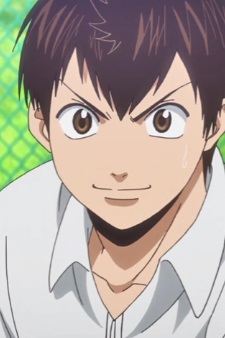 Eiichiro Maruo Show's protagonist and tennis savant whose note-taking skills have made him a formidable talent in the prefecture. 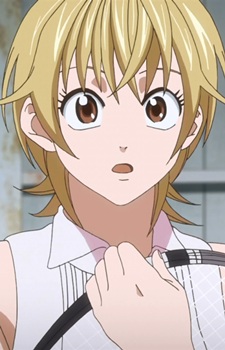 Natsu Takasaki The not-lovely, sort-of love interest of Maruo. I say sort of because he doesn't quite know it yet, but he'll get there eventually. She is also a well ranked player hoping to become a pro player one day, and is the one who initially introduces Maruo to Southern Tennis Club, where she practices. 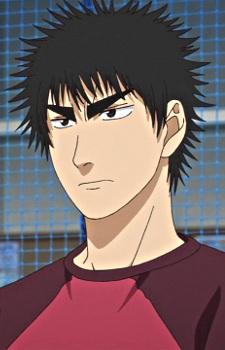 Takuma Egawa The top ranking player in the prefecture, and good friend of Natsu. He is also a member of STC. Though a very good player, he's been in a bit of a slump lately.  Yukichi Fukazawa Another member of STC who quickly becomes friends with Maruo. He mainly exists to tell us about the other players Maruo goes up against. Calls Maruo big bro for some reason.  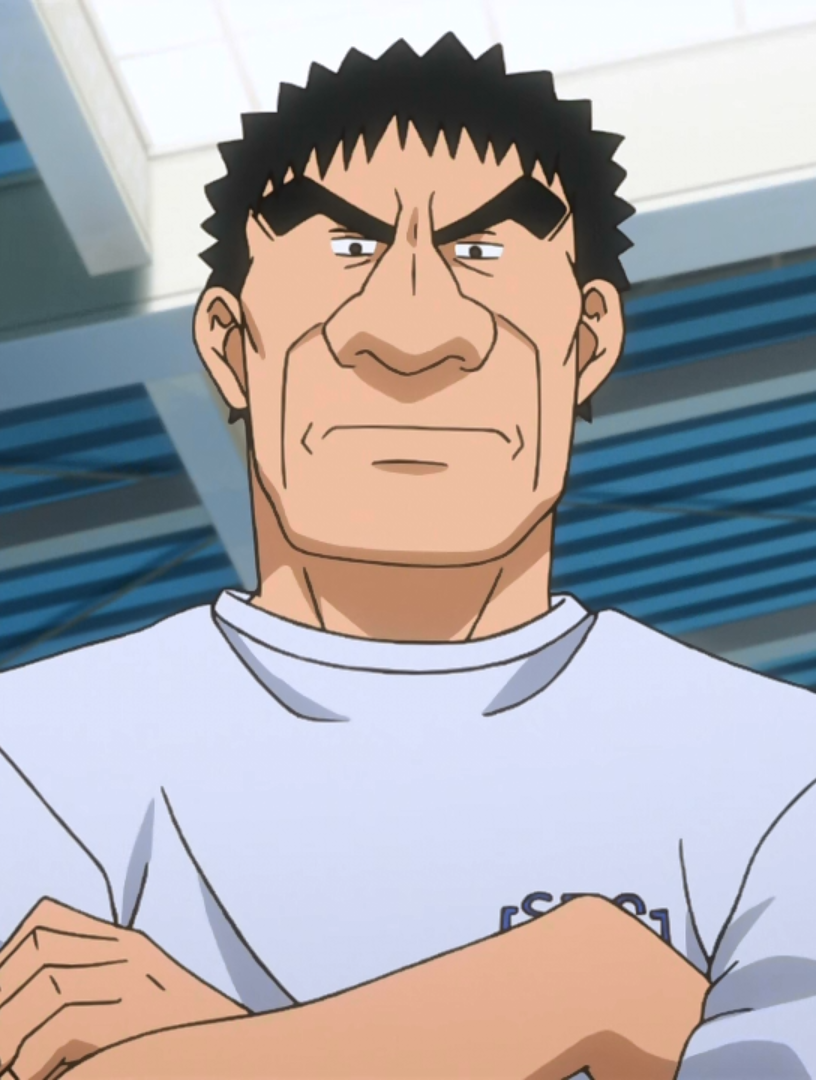 Miura A coach at STC who has taken Maruo under his wing. The entire first season is up on Crunchyroll, and they've also picked up the second season as well. As a long time tennis player myself, I'll be doing info posts about every episode unless I forget or there's literally nothing worth saying. I've done most of the first season, but I stopped watching before episode 16, so I'll be doing info posts on those as I catch up as well.
|
|
|
|

|
| # ¿ May 16, 2024 02:32 |
|
Episode 16 Ei's strategy here is pretty legit. As a short, scrawny, weakling like him, the best way to counter a power-player is to hit the most awkward shots possible. It's really hard to hit a low slice with a lot of power because not only is the ball well below the net, it's also spinning backward which means that, unlike with top spin, the ball won't inherently bounce at an upward angle off the racket. That forces you to have to "pick up" the ball, which is not something that a power player would be comfortable with. 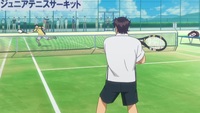 e: For some reason this image is tiny.  That volley is no joke. Even if you guess the direction, it's still a hell of a stretch to get it when it's that wide even with explosive movement.  Not really... well, it depends on the player. Araya is characterized as being fiery and impatient, so there's a good chance this strategy will work against him. But if Araya could control his patience and stay focused, he would have no trouble punishing Ei for those lobs. Also, you might tire yourself out with that frantic defense faster than Araya's hard hitting will tire him out. 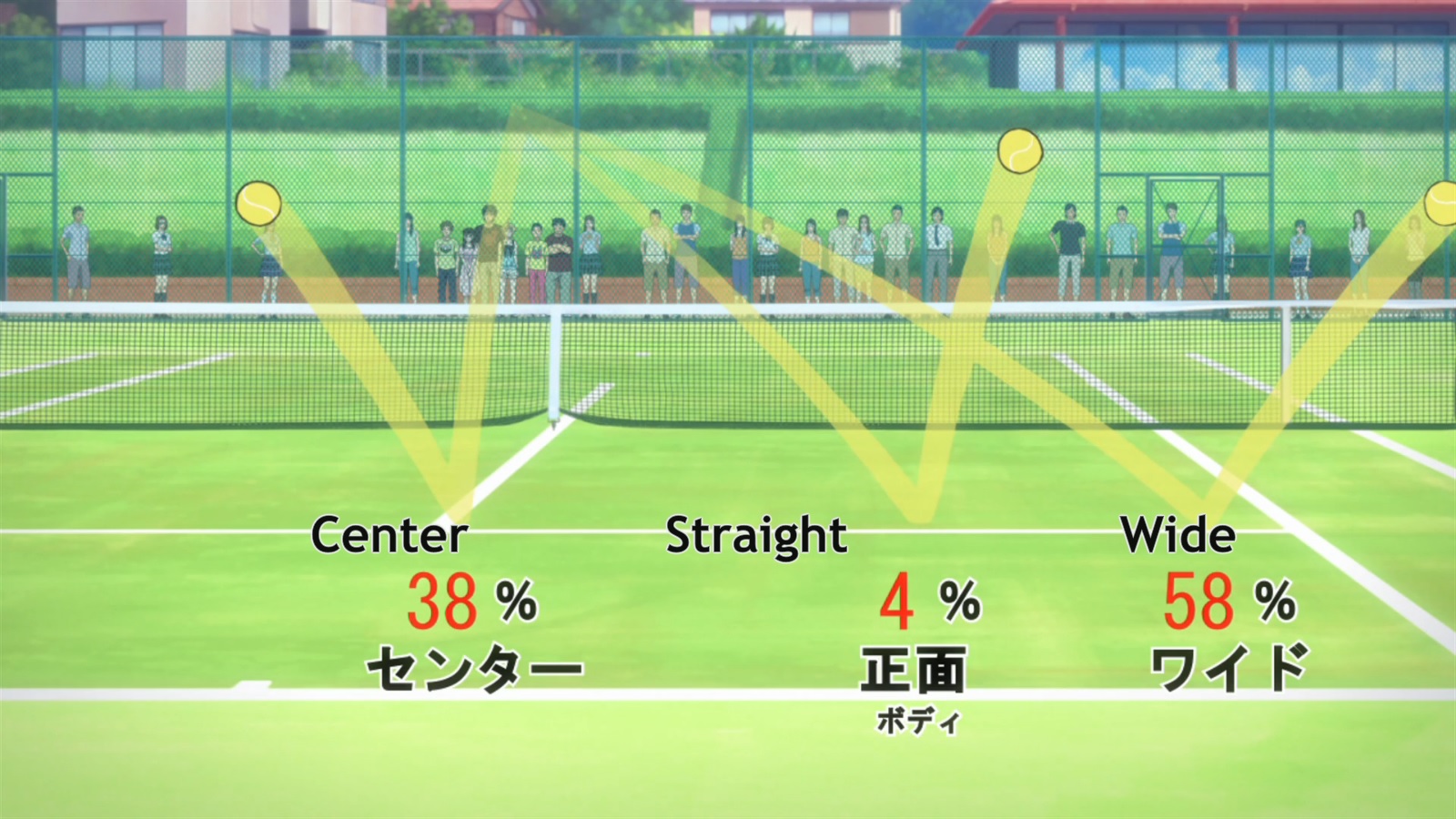 Seriously, Ei is superhuman if he can keep track of stuff like this while fighting that hard for each point.
|
|
|
|
Episode 17 Egawa VS Araya: A 200kph (~120 mph) serve is no joke. That's what most pros average. I think I have a pretty good serve, but I could maybe get that if I threw everything I had into it and didn't worry about aim. On a different note, a lot of the animation in this match is actually really good and feels pretty true to life. I wouldn't be surprised if a lot of those were drawn directly from reference. On yet another note, how old is Maruo again? Either way, going pro as a teenager is really special, and it's also when many of the top players started playing professionally. One of the notable few who didn't is John Isner (USA) who did a full 4 years of college before turning pro.
|
|
|
|
Not much to say about episodes 18, 19, or 20 that the show didn't present in all it's brutal glory. I'm technically a casual player so I've never gone through that level of training before. Watching that kinda makes me want to... but on the other hand I'm a lazy bum and probably couldn't last more than 10 minutes.Yinlock posted:I heart Baby Steps. It's kind of the anti-sports-manga in a lot of ways character-wise. It kinda manages to twist or sidestep all the normal character beats. The only real common thing is people being inexplicably excited about high school tennis but that's kind of a given. Yeah the tournament is definitely a lot more legit than any local tournament I've ever seen. Maybe it's different in japan or in other places, but I've never seen a local tournament where each match gets its own ref.
|
|
|
|
Mo_Steel posted:So happy this is back up for another season. As someone who barely played tennis in gym class in high school one or two times the series (show and manga) have been pretty informative, and have raised my interest in the sport a lot. I keep trying to get myself to actually catch some real matches, so hopefully season 2 will reignite that. There's a lot of new rising stars poppin' up all over the place all of a sudden, so now would be a pretty good time to start watching (things have been pretty stagnant for a few years now). Also, if you happen to be japanese, Nishikori had solidly parked himself in the top 10 since the end of last year (5th as of right now) so japan finally has someone to cheer for. I wouldn't be surprised if he's the most sponsored player on the tour right now with all of the sponsorship deals japanese companies are throwing at him.
|
|
|
|
LorneReams posted:Is the number grid a real thing, or is it just a metaphorical representation for the viewer to show what he is trying to do? Personally I've never seen a coach do that, but it doesn't seem too far fetched for a small sized grid like the 9-square one. The 100-square grid that Maruo is imagining seems absurd though, cuz that's a lot of time and effort to make. Instead, a coach would basically have you do target practice by trying to hit an object placed at a couple corners or something.
|
|
|
|
Maruo VS Nabae (21/22/23) Oh boy. I'm feeling vicariously frustrated for Maruo. Nabae is like an amorphous blob that you're trying to kill with bullets. It doesn't matter what kind of gun you used, it's just gonna absorb it all and spit it back out. The only way to beat that is... well, bigger guns. In Maruo's case, that means playing so drat well that counter-strategy becomes meaningless. That could mean hitting absurdly hard, using absurd amounts of spin, or trying for absurd levels of control to place absurdly high-risk shots. Back when Roger Federer showed up, what made him so unbeatable was that he was able to create impossible openings. It didn't matter how well you played a point against him if he could hit a winner with a casual flick of his wrist. That's basically what Maruo tried to accomplish. But one thing I distinctly noticed is that Maruo was only ever going for the corners. As far as showcasing control that's all well and good, but what he should be aiming for is the doubles line, especially at a point farther in from the base line. That's an even sharper angle and it puts the opponent in an awkward position. ViggyNash fucked around with this message at 04:05 on Apr 3, 2015 |
|
|
|
Season 2, Episode 1: Yes, this is a real thing:   I really like the op this time around. They definitely put some effort into getting the form for all the players right. Maruo vs Alex So a note about American tennis in general. America's last real heavyweight was Andy Roddick, who was quite big in the early 2000's, especially after Pete Sampras's retirement. Andre Agassi, who ended up being mostly second to Sampras, also kept playing through the first decade, but he never really regained his former glory and retired tearfully at the US Open in 2006. So, it was Roddick who defined the next generation of tennis and, well... it wasn't good. Roddick's entire game revolved around playing faster and harder than anyone on the tour could handle. With his unique serve, he was able to put up several Guinness world records for the world's fastest serve, and was able to reach the #1 position. However, as soon as everyone figured out how to counter his speed and power, he was screwed. It took him years to increase his game's flexibility, but he was never able to make it back to the top. Many of the other American pros had the same problem since their games also revolved around speed and power, and so America had a sort of dark age of tennis while newcomers tried to break away from Roddick's legacy. John Isner, the current top American, is definitely rooted in that style, but he also makes very good use of his fantastic serve to set up easy finishers, not by overpowering the opponent (though he does hit some pretty fast serves) but by hitting them at extremely difficult angles. He's also like 7 feet tall so that helps. Alex's game sort of reflects that. He plays a heavy, aggressive game to keep his opponent off balance until he can go for the winner, but he's also willing to go to the net if given the chance.  Not every ball is manufactured by the same company, obviously, and while there are standard specifications for a tennis ball, there's enough leeway that different balls can feel very different. Things like the weight and the felt can really change how a ball reacts.
|
|
|
|
XboxPants posted:I think this is a translation thing; usually when I see "heavy" being used in this context, it's in the sense of a powerful shot. Like, it's "heavy" because the opponent hit it so hard, not because the ball is physically heavy. Like a "heavy hit". Cool info regardless, tho. Your posts are awesome and make the show way more enjoyable. Maybe, and it fits in with my noting that american tennis was about playing hard and fast. My first thought was that it was a different ball so I stuck with that. Different places would probably have different preferences for the balls they buy or the balls that are available to buy so it makes sense that the tennis academy would have different balls than the ones Maruo is used to in his prefecture.
|
|
|
|
S2 Episode 2: "Look at the opponent and the whole court..." This is something that players are told or learn early. The problem is that it's hard. It's the reason why practice tends to be about repeating your strokes ad infinitum, so when it comes to a match you don't have to think to hard about hitting the ball and instead focus on keeping track of the court and your opponent. "What exactly do I do to get my instincts confident again?" Tis a question that all pros face on a regular basis. Each have their ways of dealing with it, or not dealing with it, but Djokovic, the world #1 for the last couple years, deals with it in a way similar to Nabae... but far more extreme. At this year's Australian Open, which was held in January, the finals featured Djokovic and Britain's Andy Murray. In the second set, Murray started to pull ahead early on and had a lot of confidence. But then Djokovic starts displaying signs that there was something wrong with his leg. He all but gave away the next couple games. Then he steals a game from Murray. Then another. And another. My this point, Murray is a mental mess, and even though he was still in the lead at that point, he quickly lost the set. Basically, it was all an act meant to confuse his opponents, but he was willing to give up several games in the process in hopes of the long term victory. For the average person, it's all about the little victories, as Maruo soon discovers.
|
|
|
|
Season 2, Episode 3 There is no such thing as flat spin. That's an oxymoron. The definition of "flat" is hitting a ball in a neutral way such that spin is minimized. I really didn't expect them to make that obvious a mistake, ever. What they meant to say, I think, is that Alex's down-the-center serve has reverse spin, or lefty spin. Aside from that... uh, hiccup, Maruo has some really good strategic planning this episode to counter Alex. Like top tier mind games level planning. If anything is going to become Maruo's real weapon, it'll probably be that level of planning. On the other hand, it seems like Alex sacrificed that first set in favor of drastically changing his play style. That is not an easy thing to do. There are plenty of pros who couldn't change within a match even if they tried because they're so used to their own strategy and style. On the other hand, top tier guys like Djokovic, Federer, and Nadal do it pretty much on the fly whenever they feel like because they're just that good.
|
|
|
|
LorneReams posted:I think he was saying "Flat" was the type of spin (as in no spin). I chalk it up as a translation issue. Could be. Does anyone know what the kanji says literally, where they translated it to "flat spin"?
|
|
|
|
Emalde posted:It's not kanji. It very literally says "Center - 30% (Flat Spin)" So a production error I guess. But, side note, a slice is just a type of shot that produces a lot of spin so the <slice/spin> part would be redundant. 
|
|
|
|
So I missed the last few episodes due to things happening and being to lazy too make an effort post. But I've got plenty of time now. Maruo vs. Alex Alex gave up on improving his backhand and instead started running around the ball to hit a forehand. That's me just about every time I play because I forget how to hit my backhand every two weeks. Also, inside-out forehands are so freaking satisfying. I don't know why, but I love them. And then Maruo does my next favorite thing: hitting a ball hard and deep, then moving up behind it. And then Maruo figures out something that tends to trap a lot of players: over-thinking your shots can cost you a lot. Hell, I still fall into that pretty much every time I play because I never have the confidence to let go, and I suffer a lot for it. Maruo vs. Takuma Holy poo poo, Takuma's 500 in the world? He might not be going to any grand slams any time soon, but he could probably get himself into an ATP 250 or 500 level tournament, which is still a big deal. As for the actual game, Maruo is totally right about how to improve his serve. I've always had a good serve, but it came and went with my mental and physical state. It wasn't until I managed to ingrain the general motion and rhythm of my serve that it got consistently good. Now, even if I'm in a bad spot mentally or physically, I can still rely on getting in at least a half-decent serve. This also ties into why Coach Aoi stopped the match. I've been there, it sucks. This is more of a side note, but if a ball you hit tips the net and may or may not go over and get you a point, it's pretty bad etiquette to yell out "Go over!" Pros generally give some sort of quick apology to the other player. And when did Kageyama become such a bro? Is Suna somehow affecting shows he's not even in? ViggyNash fucked around with this message at 19:19 on May 14, 2015 |
|
|
|
LorneReams posted:Why did the coach stop him? Was it really injury related? Thanks! AVeryLargeRadish posted:I thought it was really obvious? He was trying to change his serve and was risking straining his muscles and joints in doing so, a badly pulled muscle can be nearly unusable for weeks afterwards and that would completely gently caress up his training schedule and endanger his chances at the tournament. Even worse he could tear a ligament trying to stretch things too far and that would just kill his chances outright. P-much. Technically that goes for any kind of shot that you hit, but it's especially important with serves because it's generally the single most mechanically complicated shot in your repertoire. Like actual mechanical things, the more complicated it gets the more likely it is for a part of it to get hosed up by either pushing it beyond its capacity or just by getting worn down. In order to reduce the chance of that happening, you can either simplify and refine your service motion, or slowly but steadily build up your body so that it can perform the serve consistently without problem. A lot of the injuries that actual pros face are generally due to the nature of their strokes. Strokes that strain a particular joint or muscle will increase the risk of injuring that joint or muscle. Del Potro is one of those guys that came in looking really promising and got some amazing results, but he quickly succumbed to injury because of his super awkward forehand and backhand that put absurd amounts of stress on his arm joints. On the other hand, Federer has pretty much never had an injury because of how smooth and refined his form is. He had some back strain back in 2013 that dropped him out of the top 4 for the first time in... well, forever, and back in '08 he got a mild-ish case of mono that took him out for quite a while, but that's it over his more than decade-long record.
|
|
|
|
First, a moment of silence for Nishimura. Poor guy. Maruo vs. Miyagawa Ah, so that's your shiny new weapon: hitting ground-strokes out of the air. That's a really high-level shot that a junior player is more likely to miss than make, and yet Miyagawa seems to have built his game around it. Story-wise that feels like a contrived skill to give a character, since it's really unrealistic that someone would be so utterly incompetent at volleying that they have to substitute for ground-strokes. Even at the top-tier, that kind of shot isn't used all that often. Certainly far more often than in lower levels, but generally sparingly. As for the match itself, it seems Maruo's shiny new serve lives up to the hype, and he easily takes the first game. But he soon realizes that just playing the ball deep when he doesn't have the advantage of serving isn't gonna cut it, especially against someone who's specialized in baseline play. Personally, I'd go with doing what Maruo does next: when Miyagawa moves up, hit low balls that bounce short. Or, as Maruo puts it, aim for the feet. Even if you're good at volleys, low balls that bounce very close to you can be very hard to deal with. Most higher level pros will try to convert that low ball into a drop shot since all it requires is a well-aimed block. But you need really good feel for the ball to pull that off. Miyagawa, on the other hand, is gonna have a bad time trying to hit a groundstroke that doesn't give Maruo an advantage. Lastly, a moment of silence to Miyagawa. Poor guy.
|
|
|
|
Mo_Steel posted:Is it me or did the animation quality sky-rocket for that episode? The actual tennis playing with the ball traveling from the player perspective was pretty drat sharp. Even Maruo's time on the line had him hopping and moving and flipping his racket. They never would have done that last bit in the first season. My guess is that their budget got upgraded for the second season so they're putting more effort into the animation, even for mostly unnecessary details like that.
|
|
|
|
PaganGoatPants posted:I'm all caught up now. The America stuff was good. Do they really have facilities that complex around here? The Bollettieri academy that it's based off of is I believe the single largest and most extensive tennis academy in the world. A huge number of top tier professionals have been there at some point in their career, so it'd have to be a top-tier facility to service them. I haven't personally been there though. Nick Bollettieri himself is an internationally famous coach.
|
|
|
|
PaganGoatPants posted:It's like Disney World for athletes I'm pretty sure the only reason someone would go there is if they're filthy rich and have no shame or are already competing on a national or international level, so really the cost is meaningless really.
|
|
|
|
Nihilarian posted:The match with Miyagawa ends in chapter 111 in the manga, and looking at the wiki there are 342 chapters out in Japan. So we've got enough for another season or two. That's good to know. As for the episode...  The gently caress is that? Why is there a concrete building at the back of a tennis court, and why is the rest of it a grass hill? Who the gently caress would build a court like that? Maruo vs. Natsu was a fun match, mostly because of Maruo freaking out when Natsu didn't do anything he expected her to. That's not really a bad way to play since it'll throw off your opponent, but you'd need the mental strength to be confident in such a roundabout approach, and the physical and technical ability to play flexibly. The major downside is that a player with quick enough reflexes could easily take advantage of her inefficient shot choice and punish her. Her coach mentioned that her opponent for the finals plays similar to Maruo, so that could very well be why Natsu hasn't been able to beat her.
|
|
|
|
LorneReams posted:I think he just needs to qualify (which he just did I think by making it to the semis), the better he does in the next tournaments, the better seeded he is in the open which makes the path much easier. I'm unsure if the Open is single elimination, at least at first. Pretty much all tournaments are single elimination, except for some qualifier tournaments. The number of sets may vary, though the standard is best of 3 for a typical pro tournament. As for the Araya match, you guys are correct in that he doesn't need to win, technically. But beating Araya and grabbing that first place trophy also gives him a huge rank boost, high enough that he becomes a seeded player in the All-Japan Juniors. Take a look at the full draw for the tournament that Maruo has been burning through:  Notice that all of the seeded players are spread out, such that they won't play each other until the later rounds. This is intentional, and is generally how the draw is organized in any tournament. Being an unseeded player is a detriment because it means that you'll have to play a seeded one early on... or the guy that beat the seed, which would be worse. But if Maruo gets seeded for the All-Japan Juniors, then he won't have to play a seeded player until maybe the round of 16 at the earliest. This then means that he won't have any tough matches at first, so he can conserve his energy, both mental and physical, for when the going gets rough. Match length is a very significant factor in large tournaments where you might have to play up to 8 matches over a week, maybe 2. Unless you are Ferrer, the Spanish Energizer Bunny. I am convinced he could keep playing forever and not give a gently caress. ViggyNash fucked around with this message at 05:50 on Jun 2, 2015 |
|
|
|
LorneReams posted:Viggy, come back! I got kinda sick of watching tennis what with the French Open and Wimbeldon happening nearly back to back over the last couple months and could't be arsed to watch and comment on the show. Wimbledon's done now, so it's time I got off my rear end and got back on it. Maruo VS Araya It's neat to know that Maruo serves a lot like I do. I don't mean stroke or technique, I mean in the way he's visualizing the kind of serve he'll hit, and how to follow it up, on every single serve. I certainly can't do it quite as accurately or consistently as Maruo must be, but I'm still proud of my serve. Araya mentions something that I think I've mentioned before, and that I've been thinking about for most of the show: Maruo's pretty weak. His grueling training that taught his body "active rest" only brought him on par with the field, but it did not give him the physical ability to move much farther beyond. What Maruo has been doing is min-maxing his capabilities based only on the tools he currently has, which is limited by his physique. So of course his only play here is to... figure out that Araya is left-handed?  Dammit Maruo, what is wrong with you? Obviously a left forehand is going to be different form a righty backhand! They work entirely differently! And now your backhand's broken. I can relate pretty well actually. If I don't play for a couple weeks, I almost entirely forget how to hit a backhand and have to resort to crappy slices. Dammit Maruo, what is wrong with you? Obviously a left forehand is going to be different form a righty backhand! They work entirely differently! And now your backhand's broken. I can relate pretty well actually. If I don't play for a couple weeks, I almost entirely forget how to hit a backhand and have to resort to crappy slices.On a side note, it seems like the translators are writing "winner" instead of "ace". That was sorta confusing. I like Maruo's strategy for dealing with his lack of lefty-opponent experience. It's safe and methodical, and gives Maruo time to deal with his inexperience, like he explained himself. The first point of Araya's game after that is interesting. Your first serve is obviously an important weapon since you can gamble with relatively low risk. But there is still risk, even if you get it in. Consider a first serve in which you put a lot of mental focus and physical effort into getting a quick point off the serve, but your opponent hits an ok shot back anyway. Now you're off balance both physically and mentally and have to scramble for ball. Now, about that drop shot return. That... that doesn't happen. Like, ever. The last time I saw that happen was when I accidentally framed my return slice and it happened to drop really short. That was about 8 years ago. It's just not a thing that's normally viable, especially against a solid server like Araya. Modifying your pace is, however, quite effective against many people. It's the edge that sets apart the best of the best from the almost the best. It's definitely not something that's easy to do, and it certainly doesn't come naturally. That's mostly because you have to think a lot, and most people don't like thinking while being in the hot sun for an hour and a half, or more. Oof, that bad call. People smash rackets over calls like that, especially at important points like 30-love. It's also the kind of call that might incite rage-fueled, 4-ace games. Well, that was one hell of a roller coaster to watch. 3 episodes for the match... drat. That must have been, what, 2 1/2 to 3 hours long? Take a rest Maruo, you deserve it. ViggyNash fucked around with this message at 14:40 on Jul 13, 2015 |
|
|
|

|
| # ¿ May 16, 2024 02:32 |
|
I've been neglecting you guys, I know. I haven't been watching much anime for a while 'cause I was pretty burnt out on it. I ended up only watching one show this season. Anyway, to make up for that, let me tell you a little story about the current world #1, Novak Djokovic. But first, remember when Maruo learned about Nabae's tic, where he would throw away a point every time he lost a point in an unexpected way, and that helped him solidify his mindset and get rid of that weakness? Djokovic does that too, but on a rather extreme level. A few days ago, he was playing Alexandr Dolgopolov in the semi-finals of the Western-Southern Financial Open in Cincinnati. Dolgopolov doesn't have a great ranking (66), but that belies how talented he really is. When the stars align, he can go toe-to-toe with the best of the best. In this match, he took the first set 6-4 and was on par in the second. At this point, it's Djokovic's turn to serve. His first serve is an ace, but he immediately grabs his stomach, grimacing in pain. Over the next few points, he looks equally pained, and signals the umpire to call out the trainer. By the end of the game, he even asks for a doctor, which is blaring-klaxons bad. They talk for a while, and ultimately the doctor gives him a pill, presumably an anti-inflammatory according to the commentators, and Djokovic timidly starts the next game. He wins a point and throws a thumbs-up to his box (term for the section where the coach, family, and other important personnel of a player sit). The second set ultimately goes to a tiebreak, where Djokovic pulls out a clutch victory. He easily takes the third set after Dolgopolov starts having pain in his foot, which cripples his legendary speed. Djokovic is somewhat infamous for doing that. If he's not doing well in a high-pressure situation, he'll call fake some issue or another and call out a trainer, then proceed to wreck his opponent's poo poo while making it look like a clutch victory. That's partly how he's been so dominant for the last couple years.
|
|
|




 . Looks incredibly expensive.
. Looks incredibly expensive.